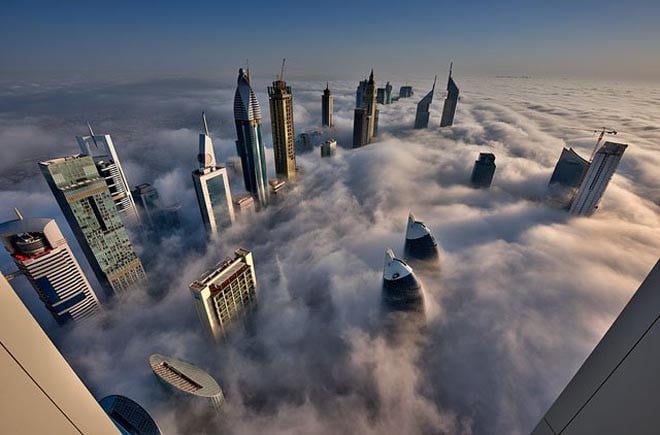
A chance encounter with an Indian in the metro and seeking the monsoon in Bollywood songs, Dubai was more palatable this time

There is another kind of claustrophobia that can only be experienced in a bustling global metropolis. More vividly if you come from a city like Lahore, which responds to development needs by expanding horizontally. Where when you step out of your house you are sure to run into someone you know.
During my first encounter with Dubai about five years back, I had felt dwarfed by its assortment of glimmering ultra-modern skyscrapers stretching to the heavens. This time around, I hear that plans are underway to integrate into Dubai’s transportation infrastructure self-flying drone taxis to ferry passengers.
The idea sounds simultaneously exciting and terrifying. The anonymity that life in this city of the future offers comes at a price.
And though I’m here for about a week, I find myself doing the unthinkable: Actively searching for a familiar face in the crowd.
Given Dubai’s diverse ethnic composition, it comes soon enough in the shape of a 30-something professional from India who works in an IT company and smiles as she sits next to me in the metro.
There is something oddly familiar about this interaction. And when the conversation starts, it flows naturally.
She tells me that she has been living in Dubai for about two years now and says that though she makes good money, there is a lot that she misses about home.
"Dubai was all sand once, I think sometimes. Of course, there can’t be a substitute for home anywhere in the world," she says.
Predictably, the romance of monsoon rains back home finds a way into the conversation. I show her a few pictures of Lahore sent by friends where the first monsoon showers have arrived and the cityscape is surreal.
"Here, you always wake up to the same sky. It’s almost always sunny," she says with a laugh. "It looks photo-shopped."
"Didn’t the UAE experience a bumper rain harvest this year? With cloud seeding it appears that things could really change," I reply.
"But we… we only needed Tansen", she jokes as her destination approaches and she gets up to leave.
I ask her nothing personal. Other than her name, Megha (Hindi for cloud), that I spotted on an identity card she was holding, everything I know about her is information she volunteered herself.
Getting to know someone a little bit in reverse, without the small talk, is a refreshing change.
I don’t want to find out more. I don’t want to connect via any means beyond the wonderful conversation we have had. Part of it is out of fear that we really might not have anything in common and the rest is just a conscious rejection of the desire for continuity. You could say that I don’t want my illusions destroyed or maybe I just want to travel light.
For the remaining part of my journey, the playlist on my phone comprises a series of musical tracks from the subcontinent steeped in the romance of monsoon rains. An ‘alive’ backdrop for clandestine rendezvous between lovers visually too: Mausami Chatterjee and Amitabh splash around puddles in a rain-drenched yet incredibly empty Mumbai in Rimjhim Gire Sawan. Her kohl liner smudges, his cigarettes go soggy. But, there is laughter and an endearing joy de vivre. Akshaye Khanna and Sonali brave the Mumbai downpour and take a bet on every conceivable mode of transport, tripping and falling over hurdles just to see each other in Sawan Barse Tarse Dil.
Weather systems, according to popular belief in the region and as depicted in these hit numbers, lay largely within the realm of the metaphysical. The subcontinent’s great maestros of music believed each season had its specific ragas with their own moods and appeals. Legend tells us that Tansen’s powerful rendition of the Deepak raga would light up flames and Megh raga would result in torrential downpours.
Though logic tells you otherwise, you buy into every word of this story each time a soulful piece of music moves you.
It is drizzling when I get back to Lahore and the fact that the airport is in shambles hits harder on returning.
On my way out of the airport building, I see a bunch of cab drivers, hovering close to the parking lot swatting flies and yawning lazily like giant cats, before they rush to market their services.
At the risk of drawing a predictable caricature - classic Lahore!
I pay close attention on the ride back home. The city looks lived in, despite the underpasses and the flyovers that are all the rage right now. The buildings aren’t as tall or overpowering. Looking up at vertigo-inducing contemporary gargantuan structures or down from mansions in the sky at the city isn’t a part of routine life here.
It has stopped raining and I roll down the car window to enjoy the breezy weather.
"Hum tum kitnay paas hain
Kitnay duur hain chaand sitaaray…
Such poochho tou mann ko jhootay lugtay hain yeh saaray"
But this?
It has existed for eons. It is real; it is not a transient place.
Maybe a comparison isn’t fair at all -- this is home, I think to myself.